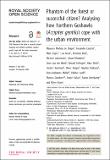Phantom of the forest or successful citizen? Analysing how Northern Goshawks (Accipiter gentilis) cope with the urban environment
Abstract
By 2040, roughly two-thirds of humanity are expected to live in urban areas. As cities expand, humans irreversibly transform natural ecosystems, creating both opportunities and challenges for wildlife. Here, we investigate how the Northern Goshawk (Accipiter gentilis) is adjusting to urban environments. We measured a variety of behavioural and ecological parameters in three urban and four rural study sites. City life appeared related to all parameters we measured. Urban female goshawks were overall 21.7 (CI95.13-130) times more likely to defend their nestlings from humans than rural females. Urban goshawks were 3.64 (CI95.05-6.66) times more likely to feed on pigeons and had diets exhibiting lower overall species richness and diversity. Urban females laid eggs 12.5 (CI95.12-17.4) days earlier than rural individuals and were 2.22 (CI95.984-4.73) times more likely to produce a brood of more than three nestlings. Nonetheless, urban goshawks suffered more from infections with the parasite Trichomonas gallinae, which was the second most common cause of mortality (14.6, after collisions with windows (33.1. In conclusion, although city life is associated with significant risks, goshawks appear to thrive in some urban environments, most likely as a result of high local availability of profitable pigeon prey. We conclude that the Northern Goshawk can be classified as an urban exploiter in parts of its distribution.
Citation
de Chapa , M M , Courtiol , A , Engler , M , Giese , L , Rutz , C , Lakermann , M , Müskens , G , van der Horst , Y , Zollinger , R , Wirth , H , Kenntner , N , Krueger , O , Chakarov , N , Mueller , A-K , Looft , V , Gruenkorn , T , Hallau , A , Altenkamp , R & Krone , O 2020 , ' Phantom of the forest or successful citizen? Analysing how Northern Goshawks ( Accipiter gentilis ) cope with the urban environment ' , Royal Society Open Science , vol. 7 , no. 12 , 201356 . https://doi.org/10.1098/rsos.201356
Publication
Royal Society Open Science
Status
Peer reviewed
ISSN
2054-5703Type
Journal article
Description
M.M. was part of the Graduate School IMPact-Vector funded by the Senate Competition Committee grant (SAW-2014-SGN-3) of the Leibniz Association. M.M. is also an associated doctoral student of the GRK2046 from the German Research Foundation (DFG). We are grateful for additional funding (Jagdabgabe) from the ‘Stiftung Naturschutz Berlin' (J0056 & J0088), the ‘Ministerium für ländliche Entwicklung, Umwelt und Landwirtschaft des Landes Brandenburg' (35-21340/7+5-51/16), the ‘Behörde für Wirtschaft, Verkehr und Innovation der freien Hansestadt Hamburg' (title: ‘Gesundheitsstatus und Ausbreitungsverhalten von Habichtnestlingen in Hamburg') and the ‘Ministerium für Energiewende, Landwirtschaft, Umwelt und ländliche Räume des Landes Schleswig-Holstein’ (V 542–42902/2016).Collections
Items in the St Andrews Research Repository are protected by copyright, with all rights reserved, unless otherwise indicated.

